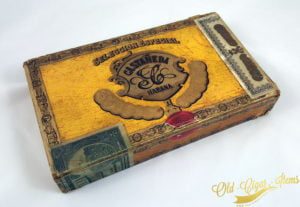Glossary
Here you will find the glossary of words to know to find your way around the world of cigars, vintage or not.
An Illustrated Encylopaedia of Post Revolution Havana Cigars : Work in progress
Cubatabaco : Abbreviation of Empresa Cubana del Tabaco, is the Cuban tobacco company. It was created in 1962 after the nationalization of the Cuban tobacco industry by the socialist government of Fidel Castro.
She managed all the production and distribution of Cuban tobacco products both locally and internationally until 1994. On that date the company Habanos S.A. was created to export cigars and cigarettes all over the world.
In 2001 the production decame the responsibility of a new entity called Tabacuba.
Cubatabaco currently owns the names of Cuban cigars brands.
Dress box : This is the most common form of packaging for Habanos, it usually contains 25 cigars. The box is “dressed” with paper labels and trimmings. Also called standard-box, current box , labelled box or semi-plain box. The semi-plain box applies especially to boxes from before World War II, where the decorations did not cover the whole box.

EMS – English Market Selection : Traditionally, the UK market has a preference for darker wrappers than the rest of the world.
This term was probably created to differentiate “EMS” and “AMS” (“American Market Selection”). “AMS” was an American creation that owes its origin to “Faber, Coe and Gregg”, a company that imported Habanos to the United States before the embargo.
In June 1992, British merchants “Joseph Samuel and Sons” and “Hunter and Frankau” began placing an “EMS” stamp on all boxes of cigars permitted to enter the domestic market. From 1998 the color of the sticker changes every year.
Habano(s) : Protected Designation of Origin (D.O.P) [Denominación de Origen Protegida (D.O.P)] designates a cigar made in Cuba with tobacco from particular areas.
Today there are 27 brands that are covered by the Protected Denomination of Origin (D.O.P.) Habanos.

Habanos S.A. : Cuban tobacco manufacturing company. It controls the promotion, distribution and export of premium cigars and other tobacco products for Cuba worldwide. It was created in 1994.
Ownership of Habanos S.A. is split equally between state-owned Cubatabaco and Spanish tobacco giant Altadis (acquired in 2008 by Imperial Tobacco).
Website : habanos.com
H.UPMANN : Herman UPMANN was a German banker whose love for cuban cigars led him to settle in Havana in 1844 and found a bank and a Habanos factory in this city.
Over time, the bank closed, but his brand of cigars persists today as an example of the most refined Habanos medium strength flavour. All its vitolas are made “Totalmente a Mano con Tripa Larga “– Totally handmade with Long Filler.
The gold medals adorning the H. UPMANN box were obtained in no less than eleven international fairs throughout the nineteenth century, as a reward for the brand’s quality and inimitable aroma.
Source : Hananos.com
Min Ron Nee : See An Illustrated Encylopaedia of Post Revolution Havana Cigars.
Partagas (source habanos.com) : If there is a particularly famous Habanos factory in Havana, it is Partagás. For many years this Factory was located at 520 Industria Street, right behind the Havana’s Capitol, in the heart of the city. Today, the Factory is located at 806 San Carlos Street.
The factory was created in 1845 by Don Jaime Partagás, and has been producing this prestigious Habanos brand ever since.
Partagás Habanos are immediately recognizable for their intense flavour. The character of its blend is of inimitable richness and aroma.
The Partagás vitolario is characterized by a wide variety of shapes and sizes.
Punch : Is one of the oldest Habanos brands. Don Manuel López de Juan Valle and cia founded this brand in the mid-19th century, with the idea of attacking the growing English market, where a humorous publication of the same name was in vogue in those days.
Mr. Punch, the clown that was the symbol of that publication, continues to appear in each of the brand’s boxes with his Habano in hand, surrounded by 19th-century images that shows the making of Habanos, and that are practically the same as those that today can be seen in factories in Cuba.
Source : habanos.com
The Great Habano Factory : Work in progress


